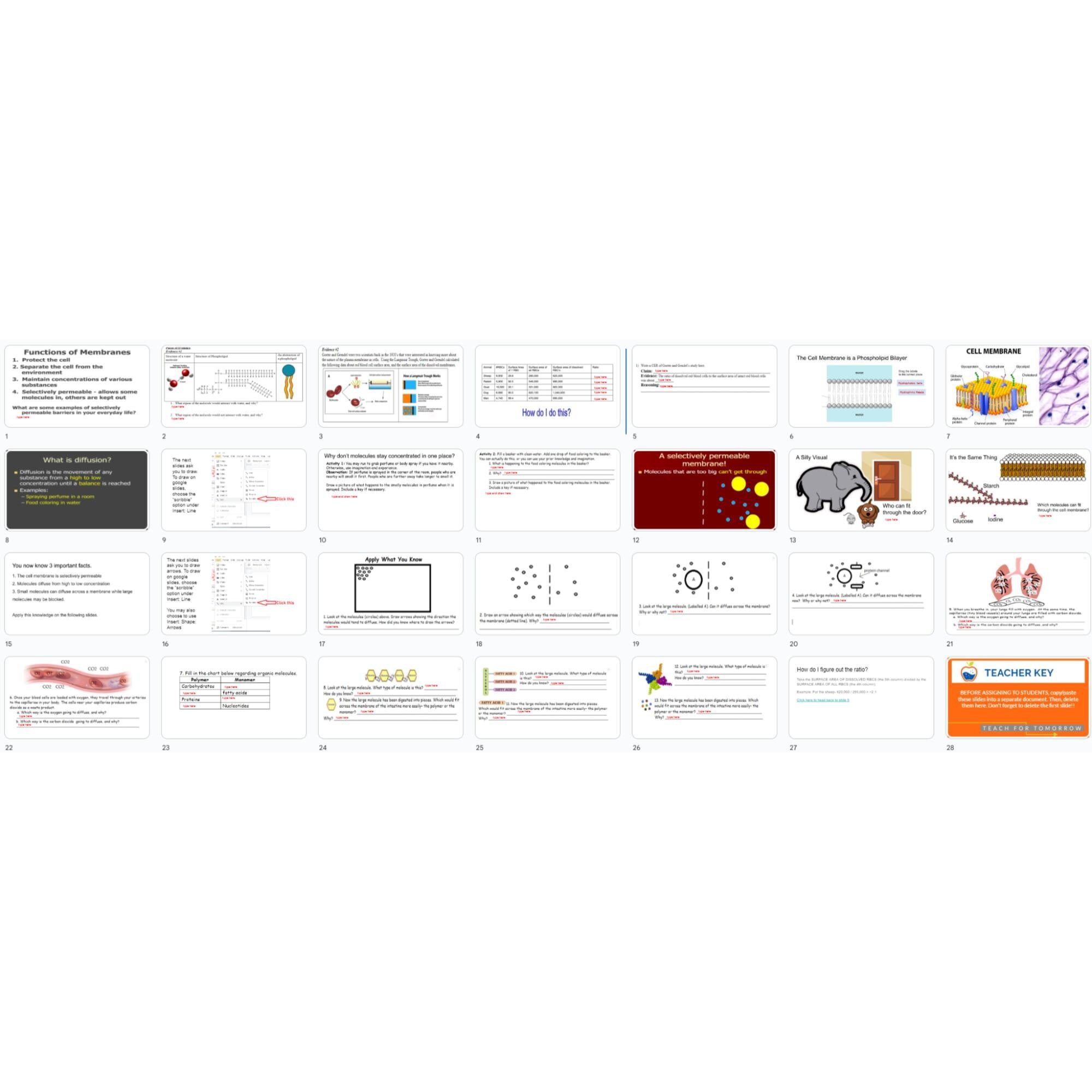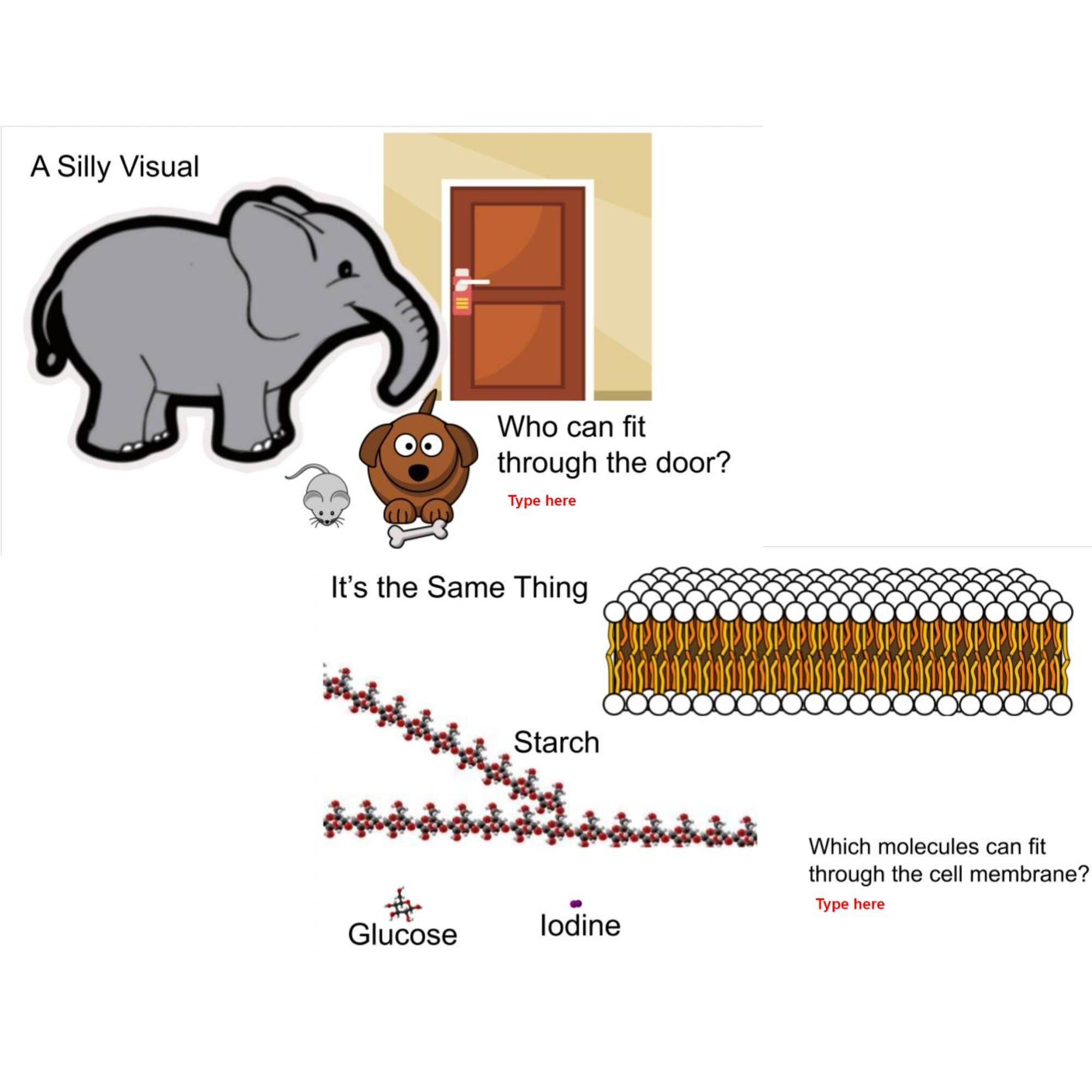 Image 1 of 4
Image 1 of 4

 Image 2 of 4
Image 2 of 4

 Image 3 of 4
Image 3 of 4

 Image 4 of 4
Image 4 of 4





Diffusion Across a Membrane
Unlock the Secrets of Cell Membranes and Diffusion!
Embark on a captivating journey through cell biology with this remote-ready Google Slides lesson. Unveil the mysteries of cell membranes, decipher the workings of diffusion, and delve into real-life examples within the human body. Here's a glimpse into the transformative learning experience:
Phospholipid Proficiency: Dive into the molecular realm as students dissect a phospholipid molecule. Discern the hydrophilic and hydrophobic ends, laying the foundation for comprehensive membrane comprehension.
Historical Insights: Explore the groundbreaking 1920s experiment by Gorter and Grendel. Analyze actual data to affirm the bilayer composition of cell membranes. Witness history firsthand as you unravel the structure of these vital cellular gatekeepers.
Diffusion Demystified: Engage in hands-on experiments showcasing diffusion's fundamental principles. Whether it's perfume dispersing in a room or food coloring diffusing in a cup, students visualize and conceptualize molecular movement. For remote learners, imagination becomes a powerful tool, allowing them to craft insightful diagrams based on prior experience.
Size Matters: Grapple with the intriguing concept that while molecules effortlessly diffuse, larger counterparts may encounter barriers. This revelation is vividly illustrated through a whimsical analogy involving animals and doors.
Real-world Applications: Apply newfound knowledge to solve ten independent problems centered on diffusion across membranes. Journey through scenarios involving gas exchange and digestion, solidifying your understanding of cellular processes.
Elevate Understanding, Empower Learning:
This lesson transcends conventional teaching, immersing students in hands-on activities, critical thinking, and real-world applications. It empowers them to dissect complex concepts with confidence and clarity.
Remote Learning Ready:
Crafted with remote learning in mind, this Google Slides lesson seamlessly integrates into virtual classrooms. Whether at home or in a physical classroom, students unlock the mysteries of cell membranes and diffusion.
Ignite Curiosity, Transform Learning:
Download this lesson now and revolutionize your classroom. Ignite curiosity, deepen comprehension, and empower students to explore cell biology like never before. Happy teaching!
To preview this product, highlight the link below and paste the address into your web browser.
https://docs.google.com/presentation/d/18t5itRld9E_gk3dpPmoCqsIjRx5gggs4SGZ2hnp8ohQ/edit?usp=sharing
Grade & Course Recommendation:
Middle School: Grade 7–8 Life Science — introduction to cell transport and molecular movement.
High School: Grade 9 Biology — foundational lesson within the cell processes unit.
Cross-Curricular Connections:
Math Integration: Measurement of concentration gradients and rate comparisons.
ELA Integration: Students construct short written explanations connecting observed diffusion to molecular theory.
Chemistry Integration: Reinforces molecular motion, solute concentration, and equilibrium.
Daily slide + literacy - based exit ticket included with purchase
Join the Lesson Laboratory and Teach for Tomorrow!
NGSS (Next Generation Science Standards)
MS-LS1-2: Develop and use a model to describe the function of a cell as a whole and ways parts of cells contribute to the function. (connection: understanding the role of the cell membrane in transport and homeostasis)
MS-LS1-3: Use arguments supported by evidence for how the body is a system of interacting subsystems composed of groups of cells. (connection: showing how membrane transport supports larger biological systems)
HS-LS1-2: Develop and use a model to illustrate the hierarchical organization of interacting systems that provide specific functions within multicellular organisms. (connection: connecting cellular diffusion to organ and system-level gas/nutrient exchange)
HS-LS1-3: Plan and conduct an investigation to provide evidence that feedback mechanisms maintain homeostasis. (connection: diffusion as part of maintaining equilibrium within cells)
Science & Engineering Practices: Developing and using models; Analyzing and interpreting data; Constructing explanations.
Crosscutting Concepts: Structure and function; Systems and system models; Stability and change
Unlock the Secrets of Cell Membranes and Diffusion!
Embark on a captivating journey through cell biology with this remote-ready Google Slides lesson. Unveil the mysteries of cell membranes, decipher the workings of diffusion, and delve into real-life examples within the human body. Here's a glimpse into the transformative learning experience:
Phospholipid Proficiency: Dive into the molecular realm as students dissect a phospholipid molecule. Discern the hydrophilic and hydrophobic ends, laying the foundation for comprehensive membrane comprehension.
Historical Insights: Explore the groundbreaking 1920s experiment by Gorter and Grendel. Analyze actual data to affirm the bilayer composition of cell membranes. Witness history firsthand as you unravel the structure of these vital cellular gatekeepers.
Diffusion Demystified: Engage in hands-on experiments showcasing diffusion's fundamental principles. Whether it's perfume dispersing in a room or food coloring diffusing in a cup, students visualize and conceptualize molecular movement. For remote learners, imagination becomes a powerful tool, allowing them to craft insightful diagrams based on prior experience.
Size Matters: Grapple with the intriguing concept that while molecules effortlessly diffuse, larger counterparts may encounter barriers. This revelation is vividly illustrated through a whimsical analogy involving animals and doors.
Real-world Applications: Apply newfound knowledge to solve ten independent problems centered on diffusion across membranes. Journey through scenarios involving gas exchange and digestion, solidifying your understanding of cellular processes.
Elevate Understanding, Empower Learning:
This lesson transcends conventional teaching, immersing students in hands-on activities, critical thinking, and real-world applications. It empowers them to dissect complex concepts with confidence and clarity.
Remote Learning Ready:
Crafted with remote learning in mind, this Google Slides lesson seamlessly integrates into virtual classrooms. Whether at home or in a physical classroom, students unlock the mysteries of cell membranes and diffusion.
Ignite Curiosity, Transform Learning:
Download this lesson now and revolutionize your classroom. Ignite curiosity, deepen comprehension, and empower students to explore cell biology like never before. Happy teaching!
To preview this product, highlight the link below and paste the address into your web browser.
https://docs.google.com/presentation/d/18t5itRld9E_gk3dpPmoCqsIjRx5gggs4SGZ2hnp8ohQ/edit?usp=sharing
Grade & Course Recommendation:
Middle School: Grade 7–8 Life Science — introduction to cell transport and molecular movement.
High School: Grade 9 Biology — foundational lesson within the cell processes unit.
Cross-Curricular Connections:
Math Integration: Measurement of concentration gradients and rate comparisons.
ELA Integration: Students construct short written explanations connecting observed diffusion to molecular theory.
Chemistry Integration: Reinforces molecular motion, solute concentration, and equilibrium.
Daily slide + literacy - based exit ticket included with purchase
Join the Lesson Laboratory and Teach for Tomorrow!
NGSS (Next Generation Science Standards)
MS-LS1-2: Develop and use a model to describe the function of a cell as a whole and ways parts of cells contribute to the function. (connection: understanding the role of the cell membrane in transport and homeostasis)
MS-LS1-3: Use arguments supported by evidence for how the body is a system of interacting subsystems composed of groups of cells. (connection: showing how membrane transport supports larger biological systems)
HS-LS1-2: Develop and use a model to illustrate the hierarchical organization of interacting systems that provide specific functions within multicellular organisms. (connection: connecting cellular diffusion to organ and system-level gas/nutrient exchange)
HS-LS1-3: Plan and conduct an investigation to provide evidence that feedback mechanisms maintain homeostasis. (connection: diffusion as part of maintaining equilibrium within cells)
Science & Engineering Practices: Developing and using models; Analyzing and interpreting data; Constructing explanations.
Crosscutting Concepts: Structure and function; Systems and system models; Stability and change